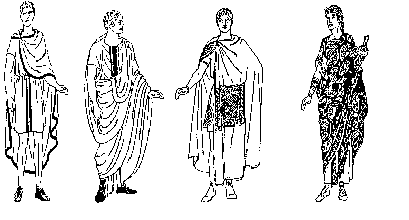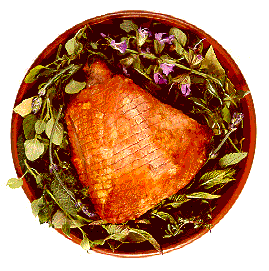
Roman Lifestyle
The Romans encompassed thousands of different cultures and comprised of diverse social, religious, ethnic and economic classes. The Roman family consisted of the father of the family, the wife, the children and the slaves of the household. The Roman family structure was patriarchal, with the oldest father of the family being the head. They lived in joint family systems where the sons' families lived with his father under the same roof. The Romans had very short working days, working at an average for 6 hours a day. The men in the families went for work whereas the women were housewives. They lived in sophisticated brick houses.
The Romans believed in public display and recognition of status through one's clothing. The Roman clothing revealed the social status of its wearer. The more distinguished the wearer, the more distinctively his clothing was marked; whereas the lowest classes had nearly no markings at all in their clothing. For example, a senator could be distinguished from a citizen by the number of stripes on the senator's tunic. Lower class working men wore hitched-up tunics. The dressing was much simpler in women. The clothing of high-class women did not have any special markings that could point out the status of their male counterparts. Instead, they wore the basic tunics, which were fuller and longer, and extended to their feet, and adorned elaborate jewelry and hairstyles in order to stand out from the other women.. The only distinction of dress allowed to women was the stola , which indicated a woman's marital status, not her social class or wealth. The stola was a symbol of marriage. It was a long, sleeveless tunic, usually suspended at the shoulders from short straps, and was worn on top of another tunic.

Roman men usually wore their hair short and were clean-shaven, whereas the women adorned elaborate hairstyles. The Roman emperors became style setters and Emperor Nero (54-68 CE) introduced curls that framed his face and sideburns. Most of the hairstyles in the women were also influenced by those adorned by the empresses. Roman women wore hairpins made by bone; hairnets made out of thin gold wire; and used mirrors made of highly polished bronze or silver, the more elaborate ones having handles and carvings. They also had creams, cosmetics and perfumes.
The upper-class Roman women wore considerable amounts of jewelry. One of the most popular designs was the fibula, which resembled the basic design of a safety pin. Since Roman clothing was mostly pinned and not sewn, the fasteners that held the dress were beautifully decorated. Earrings, necklaces, pendants, bracelets, gold rings and gems, especially garnets, were all found in a collection of jewelry from the first to the third centuries CE. Pearls were particularly valued and were expensive and more costly jewelry was set with emeralds and pearls. Besides women, Roman men also adorned one single piece of jewelry. The propriety demanded that adult male citizens wear this piece of jewelry, a personalized signet ring that was used to make an impression in sealing wax in order to authorize documents. For example, the ring could have the owner's ring in the reverse order in order to stamp his name. The rings were originally made of iron, and later with gold. These rings could also function as keys to the man's strongboxes. There is evidence that Roman men ignored the propriety and wore numerous rings and brooches to pin their cloaks. Roman boys, before they reached manhood, wore a bulla , a neck chain with a round pouch that contained protective amulets, usually phallic symbols. Some boys also wore small gold rings with phallic symbols for good luck.

The Roman social status was also reflected by their eating habits. It was believed that “You eat what you are”. The most important Roman crop was wheat, which was either taken in the form of bread or porridge. Olives and grapes were important constituents of meal as well. Olive oil was used extensively in cooking and for other purposes, such as fuel for lamps, perfume and body oils. Grapes were used to prepare wine that nearly all Romans drank or mixed with honey at every meal. The remains of grapes left after the processing of wine were used as preservatives for foods. Meat was also sparingly used in their meals. The daily routine meals for majority of the Roman population consisted of three meals, the first two being light. The first meal, breakfast, called as ientaculum , could comprise of bread dipped in watered down wine; honey, olives or dates. Next meal, lunch, called prandium , consisted of bread, fruit or cheese. Some skipped this as well. The main meal of the day was dinner or cena . It was usually served in late afternoon. It consisted of vegetables cooked in olive oil for the lower class or a several course meal for the upper classes. In the cities, grain prices were subsidized, and were even given free to the poor on a monthly basis, which was barely enough to feed the household male. The poor did not have the basic cooking facilities at home and had to go to the local baker, or pistor , to get wheat cooked. On the other hand, the rich had lavish meals that portrayed their social status. The dinner or cena consisted of three-course meal. The first course, gustus , consisted of muslum (wine mixed with honey) served with salads, eggs, shellfish and mushrooms. The second meal, lena consisted of meat like pork, poultry, fish, game, exotic birds, all served with vegetables. The final course was the dessert course. It was referred to as secundae mensae , or second table since after the first two meals, the entire table was removed and a new one was set. The dessert consisted of fruits, honey cakes, nuts and wine. Dinners were laid in the dining hall of the house, also called as triclinium . There were large dining tables, surrounded by three couches, each accommodating three people. The diners sat according to their social status. The dinnerware did not comprise of forks or knives and spoons were used for certain dishes. Usually, people ate with their hands and the slaves would wipe their hands in between courses. The guests also brought their napkins to wipe their hands and to carry leftovers home.
There were various preservation methods used to preserve food in the Roman Empire . Some of the methods used were smoking, drying and salting. This was done by either applying dry, granular salt or by immersing the food in brine. Additionally, honey was used as a preserving agent for fruits, and in order to preserve milk, the Romans started making cheese.
For fun, the Romans celebrated numerous festivals and played games. A Roman calendar was full of public holidays. Some of the games included the Gladiator, where professional and amateur fighters fought to entertain the spectators. There were man vs. man and man against animals fights and at times continued till the death of one participant. They also engaged in chariot races.